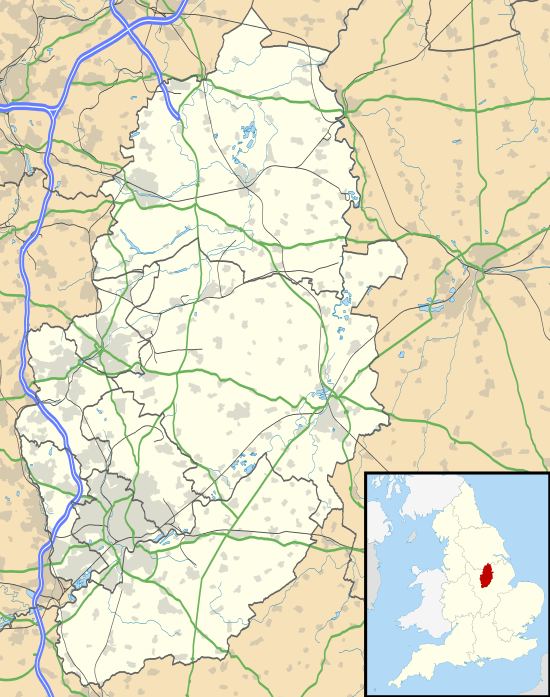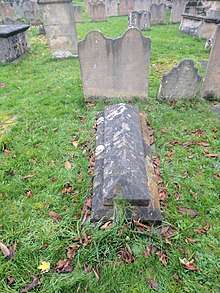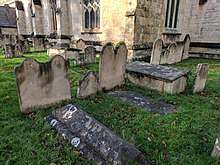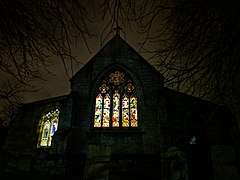Church of St Edmund, Mansfield Woodhouse
The Church of St Edmund (also known as St Edmund's or St Edmund King & Martyr) is on Old Manor Road, Mansfield Woodhouse, Nottinghamshire, England. It is an active Church of England parish church in the deanery of Mansfield, the Archdeaconry of Newark, and the Southwell and Nottingham diocese. Its benefice has three churches, St Edmund’s is the main parish church, also the Church of St Chad, Pleasley Vale and the Community Church on the Peafield Lane Estate.[1] The church is recorded in the National Heritage List for England as a designated Grade II* listed building.[2]
| Church of St Edmund, Mansfield Woodhouse | |
|---|---|
.jpg) Church of St Edmund, Mansfield Woodhouse, from Old Manor Road | |
 Church of St Edmund, Mansfield Woodhouse Location in Nottinghamshire | |
| OS grid reference | SK 54017 63212 |
| Location | Old Manor Road, Mansfield Woodhouse, Nottinghamshire |
| Country | England |
| Denomination | Church of England |
| Churchmanship | Central |
| History | |
| Status | Parish church |
| Dedication | Edmund the Martyr |
| Architecture | |
| Functional status | Active |
| Heritage designation | Grade II* listed |
| Designated | 28 January 1957 |
| Architectural type | Church |
| Style | Gothic |
| Groundbreaking | c. 1190 |
| Specifications | |
| Materials | Stone, slate / lead roof |
| Administration | |
| Parish | Mansfield Woodhouse |
| Deanery | Mansfield |
| Archdeaconry | Newark |
| Diocese | Southwell and Nottingham |
| Province | York |
| Clergy | |
| Vicar(s) | Rev Nicola Carnall |
St Edmund's Church is partnered with nearby St Edmund's C of E Primary School.[3] In the 1980s the school moved to its current site at Church Hill Avenue, Mansfield Woodhouse. The original building, on Welbeck Road leading down from the church, still stands and is Grade II listed.[4] The Turner Memorial Hall, opposite the church on Church Street, serves as St Edmund's church hall and office, as well as being a community centre and the headquarters of St Edmund's scout group.
History
Although the church is not mentioned in the Domesday Book, it is possible that a wooden church existed at Mansfield Woodhouse in the 11th century which was destroyed by fire in 1180. A church, part timber and part local limestone, was built in 1190. A fire destroyed the village and much of the church in 1304. Work on rebuilding the church started soon after the fire in 1306.[5] The fire is commemorated with an Appliqué wall hanging depicting the village and church burning (2004).
The church was reconstructed in 1804-1810 and subsequently heavily restored in 1847-150. This restoration was traditionally attributed to George Gilbert Scott.[6] Pevsner was not particularly impressed by the work, describing the result in the Nottinghamshire volume of his Buildings of England series as, "neither original nor sensitive".[6] He took particular exception to the spire of the tower, calling it "very odd" and noting the lucarne windows were "so tiny that they look from a distance like a spikey finial".[6]
Pevsner followed tradition and ascribed the building's mid-19th century reconstruction to Scott. During an assessment of the pews in St Edmund's Church by Historic England in 2007, the nineteenth century restorations of the building were re-attributed to W B Moffatt and T C Hine, rather than to Scott.[7]
External features
The churchyard surrounds the church on all four sides, with numerous mature trees and stone boundary walls to all sides. The boundary wall facing Church Street is Grade II listed.[8] The churchyard also contains three gravestones and a sarcophagus which are Grade II listed:
.jpg)
- Sarcophagus 10 metres south of south porch at Church of St Edmund[9]
.jpg)
- Headstone and chest tomb 10 metres south of chancel at Church of St Edmund[10]

- Headstone 3 metres south of Lady Chapel at Church of St Edmund[11]

- Headstone 28 metres south of chancel at Church of St Edmund[12]
.jpg)
The First World War memorial linked to the church is Grade II listed and situated opposite the church on Priory Road at the entrance to Yeoman Hill Park.[13]
Gallery
.jpg) Church Of St Edmund, Mansfield Woodhouse
Church Of St Edmund, Mansfield Woodhouse.jpg) Church Of St Edmund, Mansfield Woodhouse
Church Of St Edmund, Mansfield Woodhouse Church Of St Edmund, stained glass windows at dusk
Church Of St Edmund, stained glass windows at dusk Church Of St Edmund, stained glass windows at dusk
Church Of St Edmund, stained glass windows at dusk Church Of St Edmund, stained glass windows at dusk
Church Of St Edmund, stained glass windows at dusk
References
- Mansfield Woodhouse: St Edmund King & Martyr, Church of England, retrieved 27 December 2017
- Historic England. "Church Of St Edmund, Church Street (1251828)". National Heritage List for England. Retrieved 24 December 2017.
- "St Edmund's primary school website". St Edmund's primary school. Retrieved 25 December 2017.
- Historic England. "St Edmund's Church Of England School, With Teacher's House And Boundary Wall (1251864)". National Heritage List for England. Retrieved 25 December 2017.
- "Church History Project, Diocese of Southwell and Nottingham, History, Mansfield Woodhouse". The University of Nottingham. Retrieved 24 December 2017.
- Pevsner & Williamson 1979, p. 175.
- "St Edmund's Church, Mansfield Woodhouse, Nottinghamshire : An Assessment of the Pews, Report number: 34/2007". Historic England. Retrieved 24 December 2017.
- Historic England. "Boundary Wall At Church of St Edmund, Church Street (1262568)". National Heritage List for England. Retrieved 24 December 2017.
- Historic England. "Sarcophagus 10 metres south of south porch at Church of St Edmund, Church Street (1252004)". National Heritage List for England. Retrieved 24 December 2017.
- Historic England. "Headstone and chest tomb 10 metres south of chancel at Church of St Edmund, Church Street (1262466)". National Heritage List for England. Retrieved 24 December 2017.
- Historic England. "Headstone 3 metres south of Lady Chapel at Church of St Edmund, Church Street (1251827)". National Heritage List for England. Retrieved 24 December 2017.
- Historic England. "Headstone 28 metres south of chancel at Church of St Edmund, Church Street (1262569)". National Heritage List for England. Retrieved 24 December 2017.
- Historic England. "War Memorial, Yeoman Hill Park (1251895)". National Heritage List for England. Retrieved 24 December 2017.
Sources
| Wikimedia Commons has media related to St Edmund's Church, Mansfield Woodhouse. |
- Pevsner, Nikolaus; Williamson, Elizabeth (1979). Nottinghamshire. The Buildings of England. London, UK: Penguin. ISBN 0-14-071002-7.